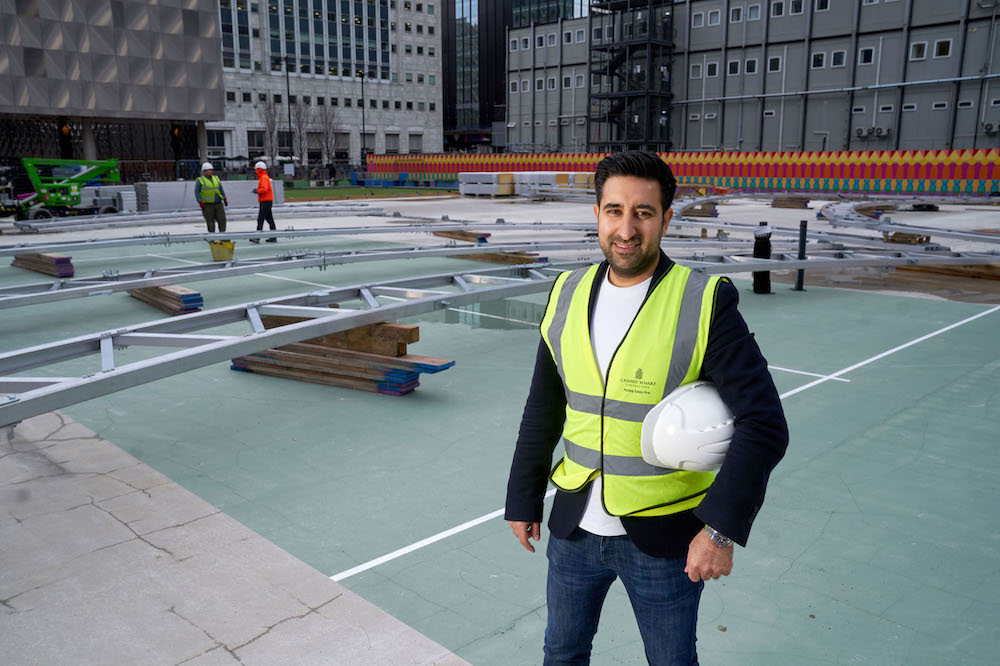Padium: building an icon
Padium padel club in Canary Wharf, London, recently celebrated its first year anniversary. Journalist Kristina Smith went behind the scenes to find out more about the construction of what is undoubtedly London’s flagship padel club.
Padium. An eight court oasis slotted between the towering skyscrapers of Canary Wharf. Within six months of opening 5,000 people had streamed through its doors and plans are afoot to add another court and roll out the Padium brand – backed by Spotify co-founder Martin Lorentzon – to a second location. But building the club wasn’t just a challenge, it was an audacious plan requiring heavyweight engineering par excellence.
Just two minutes’ walk from the top of the huge escalator that rises out of Canary Wharf tube station, Padium is not hard to spot with its three-arched roof and brightly coloured frontage nestled amongst 30 and 40-storey skyscrapers.
But what visitors to the club won’t be able to see is the engineering ingenuity hidden deep beneath the building. For Padium was constructed on a scaffold sitting deep inside a basement constructed in readiness for a future skyscraper.
“I have never seen this degree of complexity on any other site and there will probably never be another site like it,” said Paul Ross, director and founder at Edinburgh-based Padel Tech, which constructed Padium’s structure and courts.
It’s quite a statement from a company which has built padel courts in some rather unusual places, from onboard a ship to a remote Caribbean island for a celebrity client, drawing on the experience of adidas’s AFP Court installers around the world as AFP’s UK partner.
Aside from the weight of the Padium building itself, the connection between structure and scaffold at the Canary Wharf Bank Street site had to take the uplift forces of the winds blowing through the former London docklands area. With the corridor effect created by the tall buildings these can be substantial and capricious.
Designing and constructing this most unique padel facility required extensive coordination and teamwork from a large cast of companies. From Canary Wharf’s designers and designated contractors, to Padium, Padel Tech and canopy supplier Okatent, to the people who look after the everyday safety, security and logistics of London’s leading financial district, there were many issues and interfaces to juggle.
“It needed lots of eyes, lots of brain and lots of brain power,” said Paul. “It was a real team effort that delivered this project.”
Courts: 7 indoor, one outdoor
Booking: via Playtomic app (pay-and-play or membership)
Opening hours: 6am-11pm
Cost: From £80/hr/court
Address: 10 Bank Street, E14 4DE

Vision
Padium is the brainchild of serial entrepreneur Houman Ashrafzadeh, already a tenant at Canary Wharf with one of his healthy fast-food restaurants Urban Greens. Inspired by clubs in Sweden, where he grew up, Houman was keen to create a high-end padel experience in the UK.
“Back in 2019 there were only a few courts in the UK and we didn’t have premium facilities like the ones we have in Sweden,” said Houman. “I wanted to elevate the customer experience – how it feels when you step into the club, the interior design, changing rooms, courts, even the smell.”
Having considered warehouse locations on the outskirts of the capital he realised that he needed a more flagship location. Canary Wharf was high on his hit-list.
“There were four or five other operators bidding for the same site but we wanted to do something quite different,” said Houman. “Canary Wharf already knew me as a tenant through Urban Greens so they knew that I am detail oriented, brand oriented and a good tenant.”
Another happy coincidence was that the wife of Canary Wharf’s CEO Shobi Khan was already a keen padel player. And now Shobi is a fan too, enjoying games with Houman.
Engineering ingenuity
Originally Padium was to be built on a site in Wood Wharf, a good location but further from Canary Wharf tube station. The basement structure there had been constructed but, with a tenant earmarked for the level below ground, there were issues that would have complicated the structure and layout of Padium. And so Canary Wharf proposed the Bank Street site. This required an even more complex build but Houman welcomed the idea with open arms – and a vision for an even more premium club.
For Padel Tech, the shift in location meant ripping up the designs it had been working on for Wood Wharf and addressing the challenge of how to build on top of that scaffold. Fortunately, they had the expertise of Dr Mark Richards, director of NESTA Consulting Engineers, who advises Canary Wharf on structural issues.
“That scaffolding was not intended to have a building on top of it,” explained Mark. “It was designed to take loadings from an area being used for various sports but not a facility like Padium. I had to do a feasibility study to look at whether the scaffold could take the facility.”
Working with Padel Tech, Okatent, Canary Wharf-approved specialist contractors ProPlant which built the scaffold and ConCast, which constructed the concrete slab on which Padium sits, Mark helped guide a bespoke design by the specialist contractors which safely transfers building and wind loads.
But the challenges didn’t end there. In a different location Padium’s roof would have been one arched canopy, spanning from one edge of the plot to the other. However, this would have put too much force onto the edges of the scaffolding.
The solution was to install four specialist trusses running from the front to the back of the site – which is one city block in size – with three arches spanning the smaller distances between trusses. Positioning of the arches allowed the courts to be located perfectly between them.
“We needed to increase the number of point loads to spread the load across the surface,” said Andy Ponton, who was at that time Padel Tech’s design and estimating manager. “The trusses are bolted to the scaffolding and have built-in points to which the canopy is anchored. The concrete slab was initially cast up to the trusses and then the trusses were infilled afterwards.”
Some parts of the scaffolding had to be beefed up too to resist wind uplift forces from the roof structure, as Mark explained: “The scaffolding had to be strengthened along the truss lines. We married that up with the forces coming from the roof.”
It wasn’t just the final loadings that had to be considered. With input from Mark, Padel Tech planned every move of the construction sequence carefully so that the scaffolding was not overloaded, from the weight and position of construction equipment used for deliveries of steel and materials to where they would be placed.
Delivering the project safely and with minimum impact on Canary Wharf tenants and the environment were key, said Paul: “Their tenants pay a premium to know they are in a safe environment. That’s part of the USP of being in Canary Wharf. We had weekly meetings with multiple parties at Canary Wharf.”
Work to install the trusses and concrete slab began in October 2022, with Padel Tech starting on site in February 2023. Towards the end of the build Padel Tech liaised with Padium’s fit-out contractor S&G Shopfitters which constructed the mezzanine level within the club from where players can view the facility’s seven indoor courts.
Wow factor
For engineers, Padium’s ‘wow’ factor lies hidden, but for players it begins as soon as they enter the building. Walking through the front door, with the showcase centre court ahead, it feels like you might be about to play in a major tournament.
With an internal roof height of more than 10m and details including acoustic dampening, elegant, curved lighting poles, pro shop and changing rooms complete with matt-black toilets and Dyson hair dryers, Houman has worked to create his perfect club and the attention to detail from Padium’s design team is evident everywhere.
For Canary Wharf tenants the timing of Padium couldn’t have been better. It opened as big corporates were searching for ways to lure employees back to the office from home working. And its location is about to get even better. Canary Wharf has started work on its ambitious Middle Dock transformation – in partnership with the Eden Project – to create an outdoor oasis centred around the dock, with trees, gardens, floating boardwalks, water sports and spaces for arts and culture right on Padium’s doorstep.
Meanwhile, Houman is plotting the next location for a second club. The complexity of this build, alongside challenges linked to the disruption of material deliveries and rising costs has not deterred him in his mission to make Padium the biggest and most premium brand in the UK: “I know that challenges are coming and I know that I will tackle them somehow,” he said. “With five years’ experience of building a brand and a business with Urban Greens I had a lot of things in my toolbox I could reach for.”
Padel Tech echoed the sentiment: “We thrive on difficult projects. We are really looking forward to the next one.” 🎾












